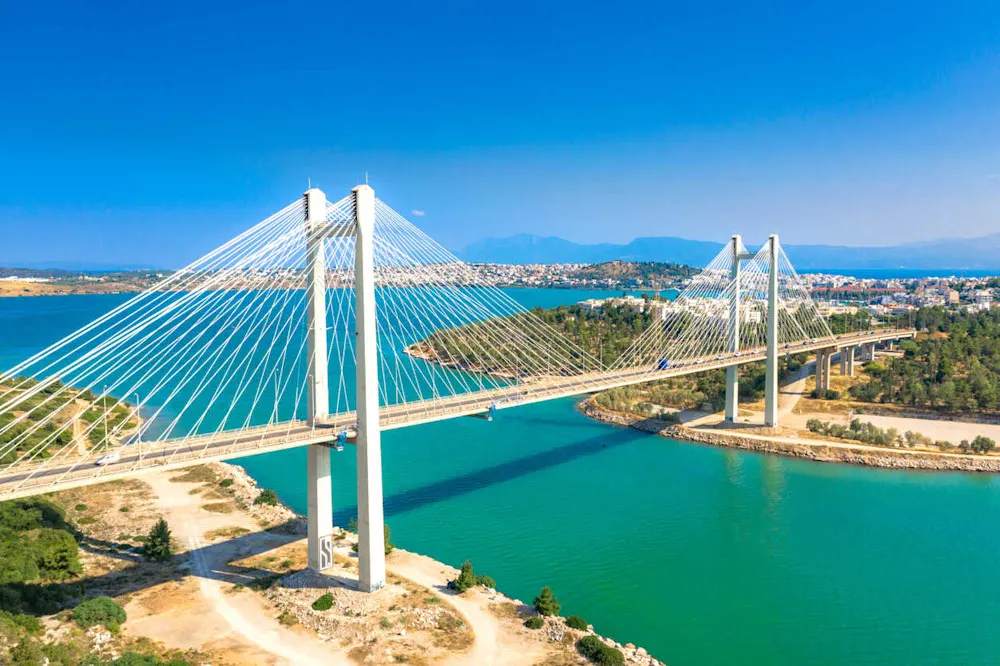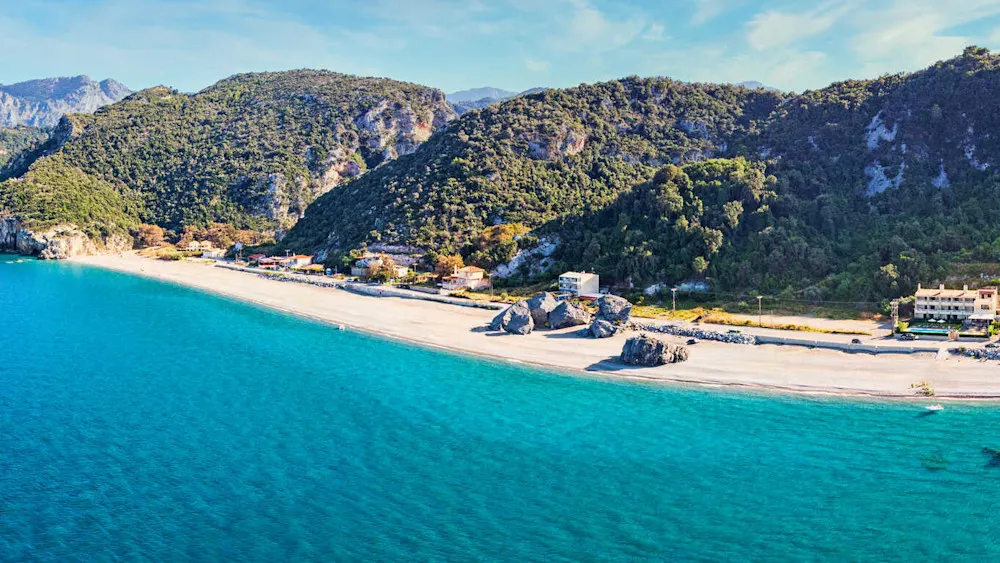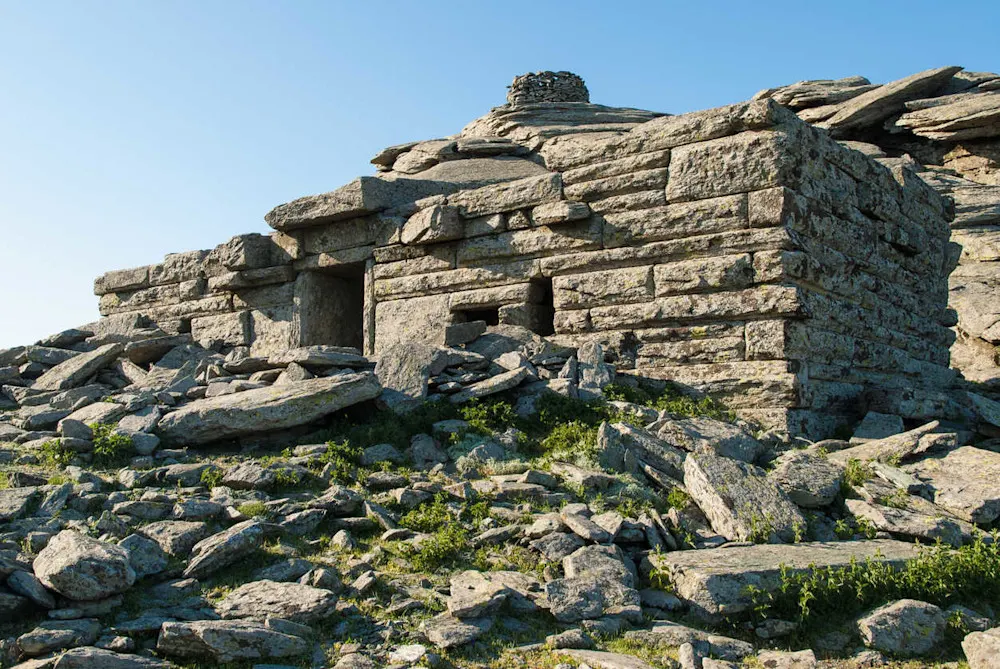If you are dreaming of life on a Greek island but are concerned about desolate winters, limited ferry schedules, or access to quality healthcare, the island of Evia (also spelled Euboea) is the ultimate Greek island hack.
It might come as a surprise to learn that Greece’s second-biggest island is also one of the country’s best-kept secrets, but it's true. With a landmass of 1,422 square miles (3,684 km), Evia is roughly the size of Delaware and one of Greece’s most accessible islands. Because it is connected to the mainland by a bridge at Chalkida, its capital city, you can drive to Evia in just 90 minutes from Athens International Airport—no ferry required.
Despite its size and proximity to Athens, the island remains largely off the tourist radar, making it a refreshing alternative to the more crowded, higher-cost choices like Crete, Corfu, Rhodes, and Santorini. With a mix of dramatic landscapes, ancient history, thermal springs, secluded beaches, and authentic village life, Evia offers an appealing combination of affordability and authenticity. Let’s take a closer look at this beautiful island hidden in plain sight.
Get Your Free Greece Report Today!
Get Your Free Greece Report Today!
Learn more about a slower pace of life in Greece and other countries in our free daily postcard e-letter. Simply enter your email address below and we'll also send you a FREE REPORT — Retire in Greece—Find Your Dream Retirement in This European Archipelago.

By submitting your email address, you will receive a free subscription to IL Postcards, Overseas Dream Home, The Untourist Daily and special offers from International Living and our affiliates. You can unsubscribe at any time, and we encourage you to read more about our Privacy Policy.
Where Ancient History Meets Island Life
The name Euboea comes from ancient Greek: "eu" meaning good and "boe" meaning cattle. It loosely translates to "the land of the well-fed cattle," reflecting the island’s agricultural fertility. While studying for the Greek citizenship exam, I also learned the seas around Evia—especially the North and South Evian Gulfs—are among the richest fishing areas in Greece.
The island has a long, colorful history with continuous settlement since the Bronze Age. Ancient Eretria and Chalkida were once powerful city-states, and Evia was a strategic location during the Persian invasions in the 5th century BCE. Over the centuries, it has been shaped by Romans, Byzantines, Venetians, and Ottomans, each leaving behind monuments, ruins, and stories. This layered past adds depth to Evia’s natural beauty, making it a fascinating place to explore. With waterfalls, thermal springs, medieval castles, and old monasteries, Evia offers plenty to discover.
6 Things to See & Do
Whether you're a nature lover, a history buff, or simply in search of a quieter alternative to Greece's more touristy islands, Evia has something to offer.
The island is about 60 miles (96 km) from Athens International Airport. The easiest way to arrive is to fly into Athens and then drive or take public transportation. Chalkida, Evia’s capital, is linked to the mainland by two bridges, making the island conveniently accessible year-round. Renting a car is ideal, as it gives you the freedom to explore beyond the main towns and into the island's rugged, mountainous interior.
1. Stroll Along the Promenade in Chalkida

Chalkida, the capital town of Evia, is the gateway to the rest of the island. Its location is part of what makes Evia so special—it's situated at the narrowest point of the Euripus Strait, and its two bridges (the Old and the New) connect visitors to the island with just a few minutes' crossing.
With over 100,000 full-time residents, Chalkida is lively year-round. It's known for its waterfront tavernas serving fresh-caught fish and classic Greek dishes like gemista (stuffed peppers and tomatoes) and baked eggplant. The city is also famous for the Euripus tidal phenomenon, a mysterious sea current under the Old Bridge that changes direction every six hours. Legend has it that even Aristotle couldn’t explain this unique occurrence. Be sure to check it out during your visit.
2. Rejuvenate in the Healing Waters of Edipsos

If you're seeking a day of rejuvenation, head to the serene town of Edipsos, a village known for its therapeutic baths, once enjoyed by Winston Churchill and Aristotle Onassis.
Located 66 miles (107 km) north of Chalkida, it's about a two-hour drive along interior roads. As you enter the village, you'll see steam rising from exposed rock formations along the waterfront, where warm spring water meets the sea.
This quiet village, with fewer than 3,000 residents, offers both public outdoor thermal pools and private spa facilities housed in local hotels and historic bathhouses. For a luxurious experience, visit Thermae Sylla Spa & Wellness Hotel, one of Greece’s top spa destinations. For a free and authentic alternative, head to the public springs along the waterfront, where locals and visitors soak in healing waters under the open sky.
3. Explore the Wild Trails of Mount Dirfis and the Dimosari Gorge
Evia’s rugged interior offers some of the most rewarding hiking in Greece, with trails that lead through lush forests, dramatic gorges, and alpine landscapes. Whether you’re after sweeping coastal views or peaceful highland solitude, the island’s wild terrain invites exploration far from the typical tourist path.
One of the most striking routes is the Dimosari Gorge, about 80 miles (130 km) southeast of Chalkida. This fairly untouched trail descends from the highlands of Mount Ochi to the Aegean Sea, winding through dense forests, past waterfalls, wooden bridges, and clear mountain streams. The hike ends at the secluded beach of Kallianos—perfect for a rewarding dip after a scenic trek.
Further north, explore the forested slopes of Mount Dirfis, the highest peak on Evia at 5,719 feet (1,743 meters). A network of well-marked trails reveals waterfalls, limestone caves, and panoramic ridge walks overlooking the North Evian Gulf to the west and the Aegean Sea to the east. Start your adventure in the traditional mountain village of Steni, known for its cool springs, rustic tavernas, and alpine charm. The trails around Dirfis range from gentle strolls to challenging climbs, making it a versatile destination for hikers of all levels. Wildlife sightings, wild herbs, and sweeping views make this area a favorite among nature lovers and photographers.
Whether you’re descending through a gorge to the sea or climbing forest trails in the mountains, hiking in Evia is a journey through raw, untamed Greek beauty.
4. Beach Hop Along the Evia Coastline

With over 400 miles (650 km) of coastline, Evia offers endless beach-hopping opportunities.
The Aegean Sea to the east and the Evian Gulf to the west provide a wide variety of beaches—from rugged, wave-swept shores to calm coves. Six of Evia's beaches have earned the Blue Flag designation for environmental quality, safety, and services.
A popular stop is Chiliadou Beach, a beautiful bay on the east coast of the island surrounded by steep cliffs and lush greenery. Its turquoise waters and cinematic scenery have even won it awards as one of the best filming locations in Europe.
If you're craving adventure, Great Sand Beach (also called Marmari) is shaped by constant Aegean winds, making it a popular destination for windsurfing and kiteboarding. Dramatic sand dunes and open horizons create a perfect playground for thrill-seekers.
Eretria Beach, on Evia’s western coast, offers a wonderful blend of relaxation and convenience. With calm, shallow waters ideal for swimming, the beach is especially popular because of its nearby promenade lined with cafés, tavernas, and shops, making it perfect for a leisurely day by the sea followed by a stroll through town. Clean, safe, and beautifully maintained, Eretria Beach perfectly captures the laid-back coastal vibe of Evia’s gulfside shore
5. Sip Local Varieties at Evia’s Wineries
Evia’s diverse landscape creates ideal conditions for winemaking, and the island is home to several family-run vineyards producing high-quality Greek wines. Located about 45 miles (72 km) from Chalkida, in the hills near Eretria and Mount Dirfis, many wineries are just over an hour’s drive away.
Expect a relaxed, intimate atmosphere where you can meet winemakers passionate about native grape varieties like Savatiano, Assyrtiko, and Malagousia. Many offer tastings paired with local cheeses and homemade olive oil, often served on terraces with sweeping views of vineyards and mountains. For a memorable experience, visit Vriniotis Winery or Avantis Estate, both of which offer tastings. However, it’s a good idea to call ahead, as some require appointments. Whether you’re a casual sipper or a devoted wine enthusiast, Evia’s vineyards offer a taste of Greek heritage in every glass.
6. Visit Historic Towns & Castles

History lovers will find plenty to explore on Evia, from ancient temples to medieval fortresses.
Just across the Old Bridge from Chalkida, perched on a hill above the Evripos Strait, stands the Ottoman-era Karababa Fortress. Built in the 17th century to defend against Venetian attacks, it offers sweeping views of the town and sea. The site features thick stone walls, a small chapel, and walking paths that invite exploration of both history and scenery.
Next, head to Eretria, once a powerful city-state of ancient Greece and later revived after the Greek War of Independence. About 30 minutes by car from Chalkida, the town is home to an impressive archaeological museum and one of Greece’s most important excavation sites. Highlights include the ruins of a 5th-century BCE theater, a 4th-century BCE temple, and the beautifully preserved House of Mosaics (circa 370 BCE), where intricate pebble mosaics depict scenes from mythology.
In southern Evia, don’t miss the Dragon Houses near Styra—massive, mysterious megalithic structures built without mortar. Their origin and purpose remain the subject of debate. Further inland, the ancient acropolis of Dystos offers panoramic views over Lake Dystos and the remains of classical city walls, providing a dramatic glimpse into Evia’s layered history.
Final Thoughts
Whether you're chasing ancient history, natural beauty, or relaxed coastal living, Evia delivers—without the crowds or high prices of more famous islands. Easy to reach, livable year-round, and rich in charm, Evia isn’t just a destination—it's a discovery.
Get Your Free Greece Report Today!
Get Your Free Greece Report Today!
Learn more about a slower pace of life in Greece and other countries in our free daily postcard e-letter. Simply enter your email address below and we'll also send you a FREE REPORT — Retire in Greece—Find Your Dream Retirement in This European Archipelago.

By submitting your email address, you will receive a free subscription to IL Postcards, Overseas Dream Home, The Untourist Daily and special offers from International Living and our affiliates. You can unsubscribe at any time, and we encourage you to read more about our Privacy Policy.
